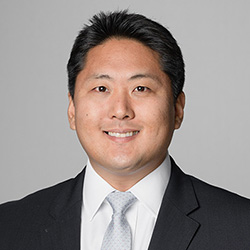Among the first real estate firms to be included in the S&P 500, EQR owns and operates multifamily residential real estate properties in Boston, New York, Washington D.C., Seattle, and San Francisco, among other major cities across the United States.
EQR's mission is to ‘create communities where people thrive’ – sustainability is a central component to that goal. The company has been reporting progress towards its sustainability goals for over a decade, is listed on various sustainability indexes including the Dow Jones Best-in-Class Index, and has been named one of America’s Most Responsible Companies for the fifth consecutive year by Newsweek Magazine in 2024.
Can you tell us about your career path and what brought you to EQR?
I started my career in engineering – my path to and through sustainability has been based mainly on practical applications and making buildings more efficient and resilient. As such, I’ve been much more focused on operational sustainability and value creation throughout my career, rather than reporting and disclosure.
Prior to EQR, I led global energy and sustainability services for CBRE’s technology, media, and telecom clients, helping them decarbonize their real estate portfolios. About one year ago, I took up this newly created role at EQR with the opportunity to advance EQR’s sustainability leadership in the industry.
What drew me to the opportunity at EQR was a combination of a few things. The opportunity to join a company that both owns and manages its portfolio was a compelling opportunity to drive sustainability through real estate as part of the core business. Also, I could tell the culture here was the right fit and would be highly supportive of both setting a high bar and achieving results over the long term.
Over the past decade, there was a major push across the real estate industry to publish sustainability disclosures and reports to demonstrate green actions by showcasing as many initiatives and case studies as possible. Disclosure and reporting will remain important to investors and stakeholders, but as we look forward, we really want to focus on initiatives that truly drive value. Our north star is value creation – whether that’s in asset values or attracting residents of the future and supporting what they will expect and demand five or ten years from now.
“Our north star is value creation – whether that’s in asset values or attracting residents of the future and supporting what they will expect and demand five or ten years from now.”
Kyle Hendricks, VP, Head of Sustainability, Equity Residential
What are the key drivers for EQR’s sustainability initiatives?
Our sustainability program is driven by three core pillars: cost reduction, value creation, and risk management.
Operating costs are important to us as an owner as well as to our residents. Every unit of energy we can save, either from efficient operations or by using better technology, will benefit our bottom line and our residents’ cost of living. Data-driven insights help us tackle efficiency opportunities at scale, putting the right information in the hands of our property teams so they can take action. We also communicate frequently with our residents, providing tips and insights they can use to operate their units as cost-effectively as possible.
We’re also taking a long-term view of our portfolio, carefully planning how we allocate capital in future years to position our buildings where they’ll need to be in the future. As systems age and require upgrades or retrofits, it’s important that we consider the benefits of emerging technologies while also balancing the practicality of operating and servicing these new systems. It’s also critical we not just think about our building assets but also the surrounding infrastructure. AI, electrification, EVs, and a combination of other demand drivers are expected to alter electricity markets in our core markets. We need to future-proof the business and proactively think about how our buildings will be profitably built and operated
Regulation is another big factor. While we’re seeing regulation get dialled back at federal level, the cities and states we operate in are moving ahead with implementing aggressive building performance standards. We think there’s a role – not just for multifamily but all real estate owners and operators – to ensure regulations are structured in a way that advances sustainability while making business sense. When there is a collaborative approach to advocacy, there is success in aligning views of policymakers and constituents. For climate resilience and long-term planning, this is a priority for us.
Climate risk is a significant consideration as our cash flows are tied to the physical assets we own. It is increasingly important to stay on top of markets where we operate and where we want to be, and to analyze how climate risks may impact asset performance over time due to hazards such as wildfires and flooding. Things that might not have been a risk in the past might be a risk in the future.
Finally, our customers are renters, and the primary demographic in the coming years will be Gen Z who care more about sustainability than any prior generation. I see an opportunity for us to differentiate ourselves by proving that our properties support the sustainable ways they want to live, but it must be a balancing act. Most residents would say they want to live a more sustainable lifestyle and the generational data supports that, but renters are extremely cost sensitive and, in most cases, not willing to pay a premium for sustainability. We are focused on amenities like EV charging, composting, and smart home technology, as well as outreach and education, to make sustainable living as easy as possible at our communities. Our residents drive the majority of our Scope 3 emissions, so it's very important to engage with them as we look to reduce our overall emissions footprint.
How is EQR leveraging data to advance its sustainability objectives?
Data is certainly a huge opportunity, especially in multifamily. We get comprehensive data at an annual or monthly level from utilities for our total energy usage – this can serve value for reporting purposes, but the frequency and granularity are not as valuable for action. The real-time data tends to be for the meters we control, such as the common areas in a multifamily property.
However, the most valuable data would be at the unit level and insight into how the residents are using their units. That would be a double win: giving us opportunities to reduce our overall carbon footprint, while allowing residents to lower their costs through smart usage or helping us address a potential issue with electricity, water, or gas use.
Unlike in the commercial space, residents don’t have corporate sustainability targets, shareholders, or much skin in the game. We do a lot of research on figuring out what motivates our residents and how to tie that to cost and living experience before investing in something they may or may not find value in.
“Unlike the commercial space, residents don’t have corporate sustainability targets, shareholders, or much skin in the game. We do a lot of research on figuring out what motivates our residents and how to tie that to cost and living experience before investing in something they may or may not find value in.”
Kyle Hendricks, VP, Head of Sustainability, Equity Residential
EQR has invested $10m in Fifth Wall’s venture fund focused on decarbonizing real estate. What emerging technologies are you excited about in this space?
Any technology that helps with building efficiency is very interesting. Throughout my career, there have been platforms that promise building efficiency with varying degrees of success. Multifamily is a particularly tough market due to the split incentive; the building owner is responsible for the capital investment, but the residents realize the majority of the financial benefit. That being said, we are highly focused on engaging our residents on sustainability – so any kind of tech we can put in a unit that gives residents a better experience and helps them operate their units more efficiently is a win-win.
Another area that we are excited about is sensor technology that delivers better data on equipment performance and predictive maintenance – all that would be super valuable for decision-making, if it can become cost-effective.
Finally, the future of electricity supply, energy storage, and load sharing are all top of mind given the push across jurisdictions to electrify. How do we take advantage of appliances, EVs, and battery storage to make our properties more flexible and resilient when incremental grid capacity may or may not be there?
What should be the key priority for sustainability practitioners today?
There’s a lot of noise and distraction right now, and it can be tempting to feel productive by reacting to everything that’s going on. I think it’s important to take a step back, determine what sustainability means to your organization from a first principles approach, and then stick to that. For us, that is the core drivers of sustainability – cost reduction, value creation, risk management – anything that can provide a competitive advantage.
I recently read a quote that really resonated with me: ‘sustainability is aligning your business to where the world is going.’ That perfectly sums up how we’re approaching sustainability at EQR.
“I think it’s important to take a step back, determine what sustainability means to your organization from a first principles approach, and then stick to that. For us, that is the core drivers of sustainability – cost reduction, value creation, risk management – anything that can provide a competitive advantage.”
Kyle Hendricks, VP, Head of Sustainability, Equity Residential


